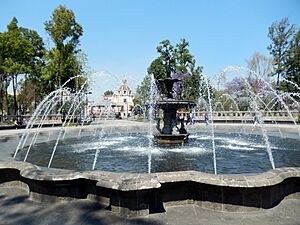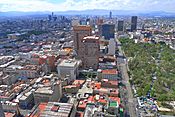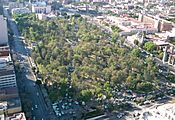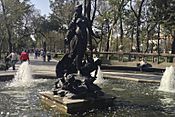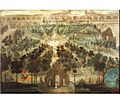Alameda Central facts for kids
Quick facts for kids Alameda Central |
|
|---|---|
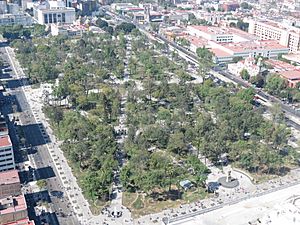
View of the Alameda Central from the Torre Latinoamericana
|
|
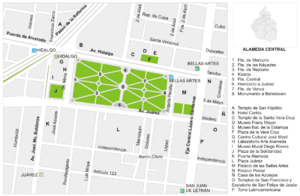 |
|
| Type | Urban park |
| Location | Cuauhtémoc, Mexico City, Mexico |
Alameda Central is a famous public park in downtown Mexico City. It was created in 1592, making it the oldest public park in the Americas. You can find it in the Cuauhtémoc borough, right next to the beautiful Palacio de Bellas Artes. It sits between Juárez Avenue and Hidalgo Avenue. You can easily get there by using the Metro Bellas Artes station.
Contents
What is Alameda Central?
The Alameda Central park is a lovely green space. It has paved paths, pretty fountains, and interesting statues. It's often used for important city events. This area used to be an Aztec marketplace a long time ago.
On January 11, 1592, a leader named Viceroy Luis de Velasco II ordered this public park to be built. He wanted a green space for everyone in the city to enjoy. The park's name, Alameda, comes from the Spanish word álamo. This word means poplar tree, which were planted there. This park was part of a bigger plan to develop the city's western edge. Today, Alameda Central is a symbol of traditional Mexican parks. Many other parks in Mexico are also called "Alameda."
Art and Statues
The park is filled with beautiful art. You can see many fountains and statues, including:
- Beethoven Monument
- Benito Juárez Hemicycle
- Désespoire
- Fountain of Mercury
- Fountain of Neptune
- Fountain of Venus
- Fountain of Virgin (the main fountain)
- Gladiador frigio
- Gladiador romano
- La Primavera
- Las Danaides
- Malgré Tout
- Statue of Alexander von Humboldt
History of the Park
The original park was smaller than it is today. It only stretched from where the Palacio de Bellas Artes is now to the Hemiciclo de Juárez. The western part of the park used to be a plain called El Quemadero, or "The Burning Place." This was a spot where the Inquisition in Mexico carried out punishments.
Around the 1760s, the Inquisition was ending. In 1770, Viceroy Marqués de Croix had this area cleared to make the park bigger. The park grew even more in 1791. At that time, Count of Revillagigedo built a wooden fence around it. This made the park mainly for rich people.
However, when Mexico gained its independence in 1821, Alameda Central became a place for big celebrations. In 1846, when President Santa Anna entered Mexico City, he even ordered the park's fountains to be filled with alcohol for the festivities.
The five main fountains in the park have a French design. They are inspired by old Greek and Roman stories. More statues were added to the park in the 1800s. Gas lamps were put in place in 1868, and then electric lights in 1892. By the late 1800s, the park was popular with everyone in Mexico, no matter their social class. The way the park looks today, with its paths spreading out from fountains, was mostly designed in the late 1800s and early 1900s.
On the south side of the park, you'll see the Hemiciclo a Juárez. This is a large, white, half-circle monument. It honors Benito Juárez, who was one of Mexico's most loved presidents.
Some of the park's statues include Désespoire and Malgré Tout, made by Jesús Fructuoso Contreras. There's also a monument given by the German community. It's dedicated to Beethoven to celebrate 100 years since his 9th Symphony.
In 2012, the park got a big makeover. This work started in May and finished in December. They replaced old pavement with marble and planted new trees. They also added new lights and fixed benches and fountains. After the makeover, street vendors were no longer allowed to sell things inside the park.
Gallery
Images for kids
-
Views of the Alameda (today called Alameda Central) and the Palace of the Viceroys of Mexico, anonymous painter, Mexico City, around 1676. Museum of the Americas, Madrid.
-
The Alameda Central in 1848 by Nathaniel Currier. Museo Amparo, Puebla City.
-
The Alameda of Mexico, taken from a balloon, Casimiro Castro, around 1869. New York Public Library.
-
A small part of Diego Rivera's famous painting Sueño de una Tarde Dominical en la Alameda Central, 1947
See also
 In Spanish: Alameda Central para niños
In Spanish: Alameda Central para niños
- List of oldest buildings in the Americas


